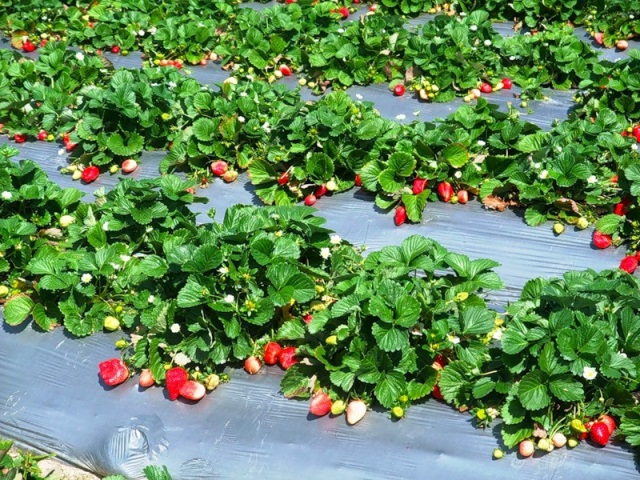Transplanting strawberries in spring or autumn and another place is an important part of the agricultural culture of crops, aimed at regulating the yield and quality of berries. To do this, it is important to know the optimal timing, learn how to select high-quality planting material and a place for a plantation. Proper organization of the event will save you from mistakes and lead to a better result - high productivity of young bushes. Now in this article we will look at how to properly plant a blooming and not just a berry.
Table of contents
Why do you need to transplant strawberries in the spring?
3 years after planting on the bushes of strawberries many buds are formed, from which mustache depart. Over time, they rise higher up the stalk, drying out and freezing during frosts. This leads to rapid aging of the main bush. He may even stop blooming.
Fruits become very shallow, yield decreases. Further operation of these bushes is inexpedient. Help in this case can only rejuvenation by transplanting young bushes to a new place. Need to sit down correctly, because at stake the emergence of new sweet berries.
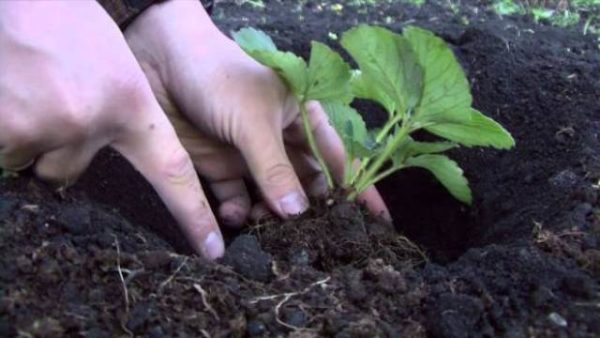
Mistakes when choosing a place to lay the plantation lead to the disappointment of gardeners. Violations of the requirements of the culture to the neighboring plants, the occurrence of groundwater and the location of the beds in cold lowlands reduces the yield and quality of berries. The only solution to this problem is a strawberry transplant.
In small areas, it is attractive to practice annual cultivation. Victoria planted since autumn after fruiting is removed, and young plants are replaced in its place. With this method on 1 m2 You can plant up to 50 plants and collect a record harvest.
When can I transplant the berry to another place?
Strawberries can be transplanted in spring, late summer and autumn. These periods are of practical importance. Plants planted in spring and autumn differ in the speed of development, winter hardiness and strength of the root system. Planted during the flowering berries can not settle down.
Spring transfer
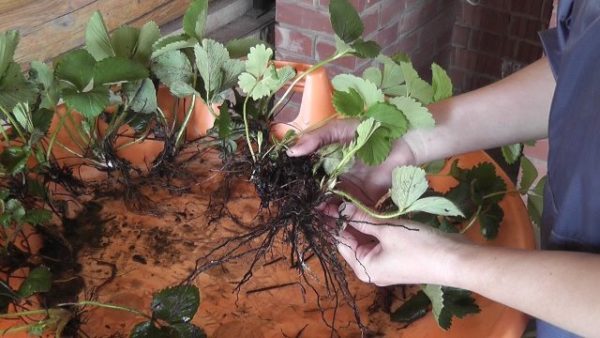
For transplanting berries in spring are oriented on soil temperature.. It should warm up to + 6 ° С- + 8 ° С. In the climatic conditions of the middle zone of the Russian Federation, this may be April or the beginning of May. In regions with harsh and snowy winters, strawberries are planted only in spring.
The indisputable advantage of spring transplantation is a guarantee of rooting of bushes before winter. Spring creates favorable conditions for the development of the vegetative mass, but there will be no budding of fruit buds. Therefore, the harvest in the first year is not worth the wait.
Summer-autumn transfer
When transplanting in the fall, they are guided by the approximate time of pre-winter frosts. Plants it is important to transplant 1 month before them. Experts recommend replanting strawberries 2-3 weeks after fruiting.
This can be done in August or early September. With later terms, the risk of death of seedlings increases.
Benefits:
- minimal care for seedlings;
- the possibility of obtaining the harvest for the next summer;
- the formation of high winter hardiness of bushes;
- saving time during peak spring works.
During the summer transplant, plants are planted in heated soil, and rains provide shrubs with moisture. Strawberry roots develop until the temperature of the soil drops to 4 ° C, and fruit buds are also laid. A strawberry transplanted in summer or early autumn does not waste force on adaptation in spring; it is directed to the development of vegetative mass and fruiting.
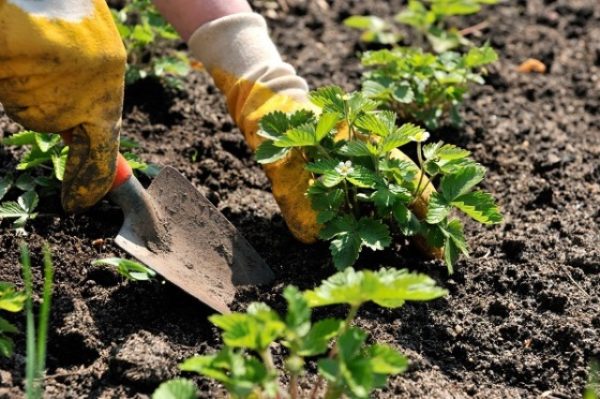
Correct transplant
First of all, they are determined with a place for future plantation and prepare the soil. At the same time it is important to take into account: transplantation is done only to a new place. The soil on the site of the former beds is freed from the roots, disinfected and removed for other crops.
Selection and preparation of a new place
Good place for a strawberry plantation plot with a slight bias. If such a place is not, choose a flat area, protected from the north winds. For uniform illumination, the ridge is oriented in the east-west direction.
The plantation should not be located in shady areas, lowlands with stagnation of water in the spring or during prolonged rains. Groundwater should lie no higher than 1.5 meters. It is not necessary to plant strawberries and at heights with intense evaporation of moisture and increased dryness.
The best predecessors of the berry:
- legumes;
- garlic,
- carrot,
- bow,
- greens, salads.

After solanaceous crops that severely deplete the soil and are prone to disease, Victoria can be planted after 1 year. Prior to this, the site is disinfected and fertilized.
Strawberries develop poorly in clay, peat, sod-podzolic and acid soils.Optimum acidity pH from 5 to 5.5.
The soil is prepared at least 2-3 weeks before the transplant of berries. When the transplant is done in spring, the beds are formed from autumn.
The soil in the selected area is dug up, remove the roots of weeds and debris. Under the digging per 1 m2 contribute:
- manure or compost 5 kg;
- superphosphate 60 g;
- ammonium sulfate 25 g;
- potassium sulfate 15 g
One day before planting, a bed is plentifully shed.
For ease of care and good development of strawberries, the width of the ridge is made 40-50 cm, and the distance between the rows is at least 30 cm. The height of the ridge varies from 20 to 50 cm.
Transfer
Planning a transplant during fruiting, note bushes with large berries, healthy stems and leaves. From them you can separate the best planting material.
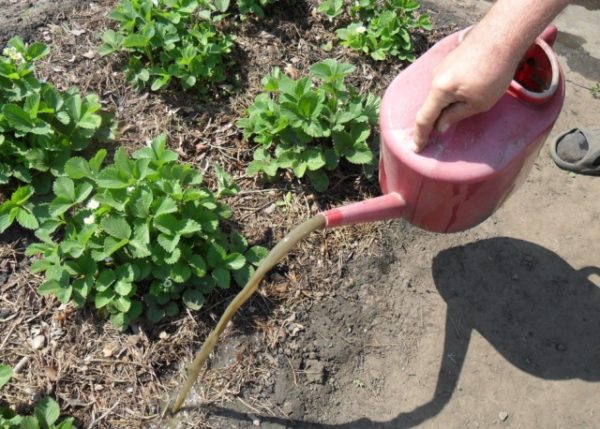
Bushes no older than 2 years are suitable for transplanting. They must have developed roots of at least 5 cm and 3-4 leaflets. From the soil they are extracted before planting on a new ridge, remove damaged stems.
During the formation of the hole take into account the location of the root collar. It should remain at ground level. Deep immersion leads to clogging of the growth point, and shallow exposure of the roots.In both cases, the plant may die. The distance between the holes is 30-40 cm.
The seedling is placed in the hole, straighten the roots and covered with soil. The surface is tamped and watered with 3 liters of warm water. Pristvolny circle mulch with peat or humus.
Good care for blooming berries in May
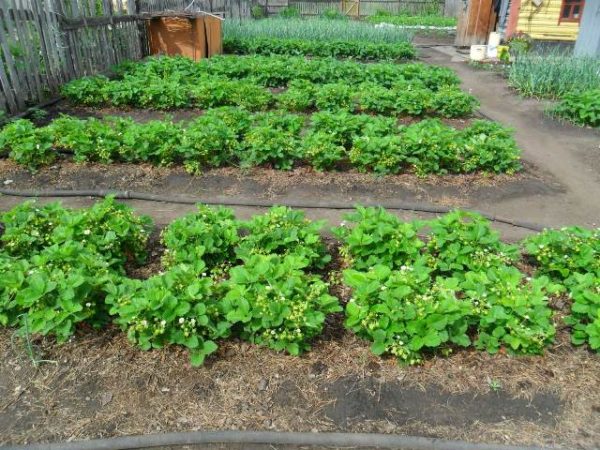
After planting seedlings moisture content of the soil for 15 days should be equal to 100%. Therefore, in the absence of rain they are watered daily. When transplantation coincides with excessive solar activity, the saplings are shaved with paper caps and plastic containers.
Soil compaction leads to disruption of root aeration, which complicates their adaptation. Therefore, loosening is often carried out while removing weeds.
When planting in autumn before frost, the soil is mulched with thermostatic materials:
- bark or pine needles;
- wood sawdust;
- spandbone.
In the winters with little snow, snow pulls up to the surface of the ridge.
Shrubs planted in the spring, after 15 days, mulch: with straw, hay, or freshly mown and dried grass.
In the first year after planting, fertilizing is not needed. Fertilizers applied to the soil provide all the strawberry needs. During summer planting, the formation of peduncles is possible, they should be cut.
In the spring and autumn of prevention of pests and diseases. It is carried out with 1% Bordeaux liquid, spraying the bushes with the working solution and the surface of the ridge 15 days after planting.
Since the cultivation of strawberries involves frequent transplantation to a new place, it is much more convenient to develop a plan of crop rotation of all plants on the site. This will save from errors in the placement of plants, planting thickening and painful search for a place when the transplant deadline is pressed.
